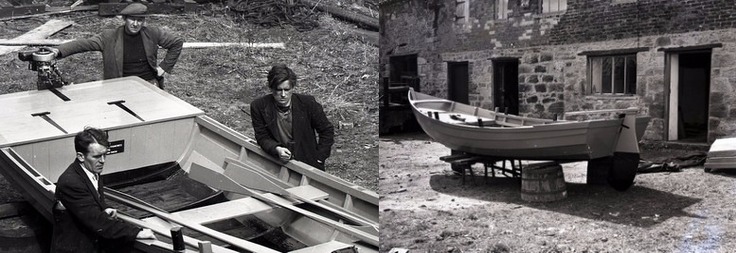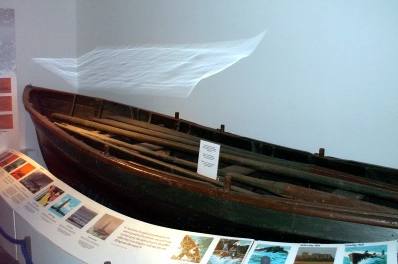The Lee family from Tweedmouth is a name synonymous with boatbuilding over the centuries, in particular the building of the famous salmon cobles which were once a common sight on the River Tweed. However two of the less well-known aspects are the Lee family’s connection with the ‘Grace Darling’ lifeboat, and the Robert Lee who was to leave the family’s boat building business in Tweedmouth, to become a Church of Scotland minister.
Robert Lee (1804–1868), Church of Scotland minister
Robert Lee was born in Tweedmouth, on 11 November 1804. He was the eldest of the three sons of George Lee, a boat builder, whose own father had established the family business; his mother was June, daughter of Robert Lambert. Educated at Berwick Grammar School, Robert spent six years working as a boat builder at the family business in Tweedmouth, but in 1824 he enrolled at the University of St Andrews where he excelled in in the study of classics. Though there may be no truth in the story, it was rumoured that he funded his entrance to St Andrews by building a boat by himself to supplement his personal savings. While he was there, he supported himself by acting as a tutor in his spare time — including among his pupils the novelist George John Whyte-Melville (1821–1878).
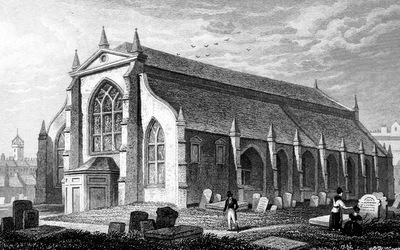
Grey Friars’ Church, Edinburgh in the 19th century, by Thomas Hosmer Shepherd (via Wikimedia Commons).
In 1833 Robert became the minister at Arbroath Presbyterian chapel of ease in Forfarshire, and in 1836 he moved to the parish of Campsie in Stirlingshire. During this time he wrote articles for the Scottish Christian Herald. In 1836, on June 21st, he married Isabella Carrick Buchanan, with whom he one son and four daughters. In 1843 he was appointed as minister of Old Greyfriars church and parish in Edinburgh, where he remained until his death in 1868. In 1844 he received from St Andrews University the degree of DD (Doctor of Divinity), and in January 1847 he became the first professor of biblical criticism to be installed in the University of Edinburgh, and Dean of the Chapel Royal.
During his career, Lee’s reformist views on methods of worship and other church matters brought him into a series of controversies with more conservative clergy and ultimately with the Church establishment. For more about the Rev. Robert Lee, see the ‘The Lee Lecture for 1968’ (PDF; from the Church Service Society Annual, 1969), by R. Stuart Louden, Minister of Greyfriars, which marked the centenary of his death with a discussion of Lee’s influence upon the development of church worship.
In the National Galleries of Scotland:
A print of Robert Lee’s original workshop in Tweedmouth, by Sir David Young Cameron (1905) – view here;
A painting of the Rev. Robert Lee D.D., Regius Professor of Biblical Criticism, by James Edgar (1853) – view here
Grace Darling Lifeboat
According to details held by the RNLI (see italic text below), it was the Lee family at their yard in Tweedmouth, who built the coble named Grace Darling in which Grace became famous for helping her father to rescue the survivors from the SS Forfarshire, when the ship was driven by a storm onto the Harcar rocks on 7 September 1838.
“Grace Darling’s coble is recorded as being built by Littlejones of Lee & Co Tweedmouth in 1828, as a boat specifically for the Darling family to use to get from the Longstone lighthouse to the mainland. The purchase was sanctioned by Trinity House who manage lighthouses in England and Wales.”
The name ‘Littlejones’ mentioned above in the construction of the Grace Darling coble is possibly incorrect, as there was no recording of that surname in the area at that time. However there was a boat builder from Spittal, with the surname ‘Littlejohn’ recorded in Pigot’s Directory, and this is more likely to be the person who worked with the Lee family on the construction of the Grace Darling coble.
Lee’s Boatyard, Dock Road, Tweedmouth
The Lee family continued to build cobles well into the 20th century for individual customers, as well as the Berwick Salmon Company at their Dock Road premises in Tweedmouth. Up to the mid-twentieth century the old craft method of building cobles was carried out, giving each coble an individual build without plans.
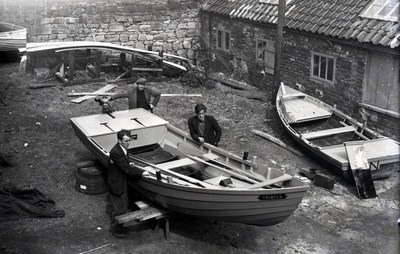
Pictured in the boatyard at Dock Road, Tweedmouth, (late 1950s to mid-1960s), beside a brand new completed coble named Thistle, are left Robert Lee, centre James Jamieson and right David Lee. Photograph: Berwick Record Office – BRO 1944-1-1936-7.
An interesting story relating to this appeared in the Berwick Advertiser in 1952 (10 July):
Lee’s of Tweedmouth work on last of the hand-made cobles
Using a larch and timber they have built many boats by hand, using only a few simple tools, including the adze, a tool that in most places fell into disuse long ago. They use no plans, for they build as they go along, adding here and taking off there, until the craft is completed to their own and the buyer’s satisfaction. Now lying almost completed in the shed is the last of the cobles they will build by hand. And they watch its completion with a tinge of regret for the passing of the craft which the family has practised for so long.
Latest Machines
Across the yard is a newly-cemented stone building and inside it contains two of the very best wood-working machines. One is a band saw and the other a planning and thickness machine which plane lengths of woods to any given thickness at a speed of 40 feet a minute. With the aid of the new machinery, the Company hopes to speed up the production of salmon cobles, and the yard will also build boats for the individual use of anglers.
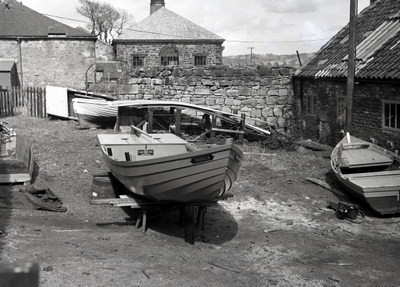
This photograph shows the newly completed coble Thistle in the boatyard at Dock Road, Tweedmouth. The former Borough Waterworks building at Dock Road, Tweedmouth, can be seen in the background. Photograph: Berwick Record Office – BRO 1944-1-1936-9.
Although Mr. Lee and Robert are looking forward to using the new machinery, they agree they will find it rather strange at first, for even bolt holes have to be bored with a hand drill. Now Robert is hoping to be using soon a brand new electric model.
Father to Son
Robert is almost finished his apprenticeship, and is soon to report for his National Service. He has been learning the trade from his father, who, in turn, was taught by his father, the late Mr Robert Lee, who was in the trade until he retired, at 84. At the start of the 1914-18 war, Mr Lee went with his father to Newcastle, but they returned after the war to work for the Berwick Salmon Company. That name Lee is an old one in Tweedmouth is shown by the fact that they have part of the village named after them – it is called Lees Lane.
So seemingly another old craft dies. But the knowledge and experience, so essential in the building of boats, remains, and will be put to a new and speedier use with the aid of modern machinery.
Sources:
Oxford Dictionary of National Biography: “Robert Lee (1804-1868)
Grace Darling Museum, Royal National Lifeboat Institution
Berwick Advertiser, 10 July 1952

